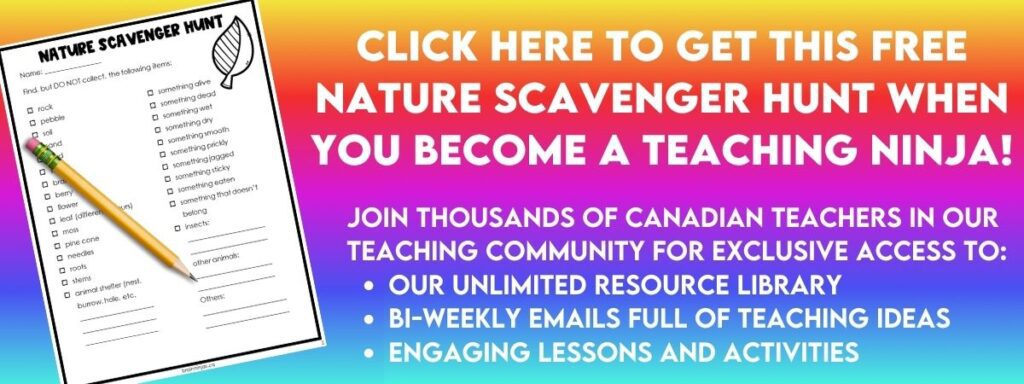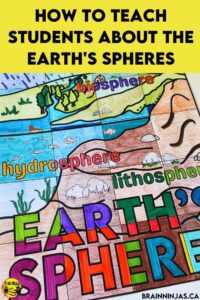
The new Alberta science curriculum asks students in Grade 4 to learn about the Earth’s spheres and how they interact with each other. That meant we got the opportunity to learn about them, too. We pulled together some of the best resources we’ve used to learn about the spheres and the resources we’ve written to help our students.
When we talk about the Earth’s spheres, we refer to the lithosphere, atmosphere, hydrosphere and biosphere. We know there are more spheres, but these are the ones focused on in our science curriculum. Learning about the Earth’s spheres helps students understand how our planet survives and thrives.
What Are the Earth’s Spheres?
Take your students outside to show them each of the spheres in the world. It’s the best way to introduce the spheres or review them.
Another way to introduce the spheres is through a simple colouring activity. Our collaborative posters encourage students to work together for a common goal. This poster shows the four spheres. Each of our collaborative posters includes 18, 24 or 36 pieces so they work with any size group. All the instructions to prepare and assemble the poster are included along with a simple follow-up activity to extend the learning or keep your early finishers busy. Find the Earth’s Spheres Collaborative Poster on TpT ($USD) or our BN Shop ($CAN).
Lithosphere (Also Known as the Geosphere)
The lithosphere is the crust of the Earth where all the rocks, soil and sand are found. It contains the tectonic plates and sits on the top of the mantle. These plates can be oceanic (under the ocean) or continental (under the land). Organisms need the lithosphere to grow and live. The lithosphere can also be called the geosphere. The names are interchangeable.
Show students the ground. This is the lithosphere. It can have plants like grass or trees and it can have water like ponds or lakes, but only the rocks and soil are part of the lithosphere. Humans live on the surface of the lithosphere.
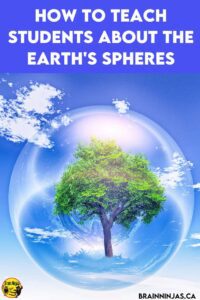
Atmosphere
The atmosphere is the protective bubble of gases around the Earth. It provides the air for organisms to survive and protects the planet from the Sun’s harmful radiation. The atmosphere is divided into levels to describe the different types of gases and the composition of the air.
Show students the atmosphere. It is all the air from the surface all the way up to space. It is made up of several gases. Your students will probably be able to name a few like oxygen, nitrogen and carbon dioxide.
Hydrosphere
The hydrosphere is about everything to do with water. This includes the water we regularly see like the oceans, lakes and rivers, but it also includes the water that moves through the atmosphere like rain, snow and water vapour.
Have your students find water? If there aren’t any puddles, ponds or lakes nearby, point out the clouds. All the moisture around the planet is part of the hydrosphere (and that includes water vapour).
This is where the water cycle fits. There are many models of the water cycle online. An easy way to model how water moves around the planet is to put a bit of water in a plastic Ziploc bag. Tape it to a window. Soon enough, you’ll be able to see the water vapour moving up the inside of the bag. In the atmosphere, this water vapour would evaporate, but the bag traps the moisture inside.
Biosphere
The biosphere is the area where the lithosphere, atmosphere and hydrosphere come together to support organisms. This is the only place where living things can survive. They depend on the other living things and the non-living things like soil, air and water.
Show students any plants, animals, insects or even themselves. All the life in the world is found in the biosphere. The biosphere is connected to all the other spheres and depends on them to survive. Point out that life requires soil to grow plants, water to keep plants and animals hydrated and air to keep all the living things alive.
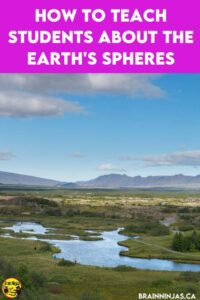
Interactions Between Spheres
When we talk about interactions between the spheres, this is any connection they have or the impact they cause. For example, the biosphere interacts with the lithosphere when plants grow in soil. Some of the interactions are essential to survival. The biosphere would not exist without the other spheres. Some interactions change the other spheres. For example, weather in the atmosphere can erode the land in the lithosphere.
Do a Scavenger Hunt
We use this scavenger hunt to get outside, but we repurposed it. Instead of just looking for the different items on this list, have students classify them by each sphere. Which items are missing? What can be added? You can get the Nature Scavenger Hunt for free when you sign up for our email list. If you’re already on the list, you can find it in the Resource Library.
Resources to Teach the Earth’s Spheres
We wrote a resource for students in Grades four to six. It comes with six complete lessons, student pages, answer keys, photographs of student examples and a digital version. There is an introductory lesson, one lesson for each of the spheres and then a lesson about the interactions once students know about the different spheres. The digital version includes loose text that your assistive technology can read. This makes differentiation easier. You can find Earth’s Spheres in our TpT Store ($USD) or our BN Shop ($CAN).
We put together a page with all our resources by grade level and topic to make finding resources easier for the Alberta Science Curriculum. Check out our Alberta Science Resources.
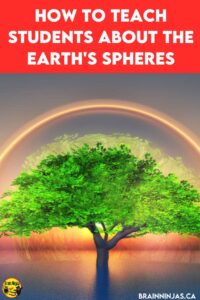
Books About the Four Spheres of Earth
We do not include affiliate links for books. Please consider purchasing books from your local bookstore. They might even be able to order books for your school at a discounted rate. We noticed multiple books with the same title. Be careful to check the author and publication date when you purchase books. We found most of these at our public library.
- The Four Spheres of Earth by Paul Larson This book is available on Epic.
- Earth’s Spheres by Rebecca Woodbury This includes other spheres, too.
- The Lithosphere by Gregory Vogt
- The Lithosphere by Karen McMichael
- Looking at Layers: Looking Into the Atmosphere by Martha London
- The Atmosphere by Karen McMichael
- The Hydrosphere by Rebecca Woodbury
- The Hydrosphere by Karen McMichael
- Biosphere by Joy Gregory
- The Biosphere by Karen McMichael
- The Biosphere by Rebecca Woodbury
Videos about Earth’s Spheres
These videos can help enhance your lessons about the Earth’s spheres. If any of these links stop working, please let us know.
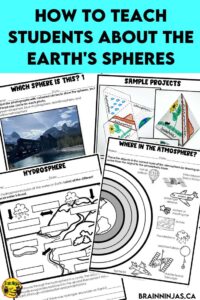
In this video, they refer to the lithosphere as the geosphere. https://www.youtube.com/watch?v=FdiiLhlPsn8 It also refers to other helpful videos and talks about the interactions between the spheres. This one is good for older students because it explains clearly without talking down to students.
This video calls the lithosphere the geosphere. https://www.youtube.com/watch?v=gWHE4ug1xpc This one is for slightly younger students, but it is full of clear information and includes the ways the different spheres interact.
This one requires reading. There is no narration, so you might want to read it for students or pause to let them read it. https://www.youtube.com/watch?v=tDbBjEYsSg4
Looking for More Science Ideas?
If you need resources for the Alberta science curriculum, start here: Alberta Science Resources.
If you teach science in Canada, these blog posts will be helpful:
- How to Shock Your Students With Engaging Electricity Lessons
- How to Leverage Critical Thinking Challenges to Your Advantage
- 10 Engaging Weather Lessons All in One Place
- How to Grow a Healthy Classroom with Plants
- How to Learn About Wetlands Without A Pond
- 15 Simple Machines Activities that Will Hook Your Students
- How to Escalate Your Chemistry Experiments
- Astronomy Lessons That Are Out of This World
- Create These 5 Fantastic Devices That Move
- Foster Environmental Stewardship in the Classroom
How do you teach your students about the spheres of Earth? Let us know in the comments below.

